HISTORY OF WAVESKI SURFING
Waveski Surfing Australia Newsletters 2005 – 2009 here
By Naudé Kotzé
Being a South African and former President of the South African Waveski Surfing Association (SAWSA), now living in New Zealand, my perspective of the early history of waveski is largely focussed on the development of the sport in the southern hemisphere.
Where did it start? According to sources, the first known sighting of people surfing waves was recorded by Captain Cook in December 1771 when he saw Polynesians surfing their canoes in Tahiti. It is difficult to find a direct relation to these early pioneers and the modern waveski, but in essence the sport of surfing in a seated position started in the early fifties by way of evolution rather than innovation. The evolution took place in a diverse fashion in different countries.
In the early 1970s the ‘Slipper’ or ‘Yak’ was also introduced to South Africa. These craft originated in Canada. The banana-shaped, flat-bottomed craft, would slip sideways, shoot up and drop backwards like a pendulum, spin, do pirouettes, facerolls and cartwheels but, lacked the proper control on the wave face and would tend to skip off the face thereby losing the wave. This craft was developed to its ultimate on the Californian coast by an American, Merve Larsen. These skis’ manoeuvres were unique and did not resemble other forms of surfing but resembled, rather, ‘kayak surfing’ of today. Many will regard Merve as the first international waveski surfer. He featured in the movies ‘Pacific Vibrations” and “Salt Water Wine” in the late sixties riding his nine foot ski in huge waves. The movies inspired Australian’s to copy and improve on the hand shaped, finless-designs. Merve also sold his kayak design in England.
Although the initial development of the modern waveski took place in America, the initial drive for competitive waveski surfing started in Australia and South Africa, who were initially not even aware of the other’s involvement in the fledgling sport. In Australia, lifeguards started adapting their skis, while canoeists in Natal (South Africa) adapted their canoes to ride the waves in their off season. The crafts also developed, to a lesser extent, in the UK.
In South Africa, a flat bottomed wooden ski, the Crocker ski, was developed. It was about 14 foot long, 4½ foot wide with the paddle attached to the nose. It was paddled out through the surf and once the wave was caught, the rider would stand up holding onto the paddle and control the ski by leaning backwards or to the side. There was the sheer exhilaration of catching the biggest possible wave and taking the drop, with the wave crashing behind you whilst you headed straight for the beach (allowing any number of skis to catch the same wave).
In the late 1960s, South African Tony Scott developed the first of the forerunners to the modern waveski. It was moulded fibreglass, flat-bottomed, 9 foot long and narrow with a kick-up in the nose – known as the Scotty Ski. The Scotty Ski’s chief advantage was that it was fast and could be turned, but required strength rather than skill to manoeuvre.
Canoeists using slaloms developed the art of riding waves in rivers and then ventured into the sea where they demonstrated their skills in controlling their craft by doing face rolls, Eskimo rolls on the face of a breaking wave or dropping down a wave digging the nose into the deep water and using the buoyancy to shoot upwards, executing cartwheels and pirouettes. However, in shallow breaking conditions these craft were totally unsuited and were easily damaged. In big surf they were hazardous and difficult to control.
With a certain level of skill required and the excitement it provided, the evolution became a revolution. In South Africa a group of canoeists belonging to the Mfuleni Canoe Club started holding the first ‘paddle surfing’, as it was called then, contests in an assortment of Yaks and Scotty Skis. They met with a howl of derisive protests from surfers who, by this time, were performing highly sophisticated manoeuvres with excellent control. Imagine the horror on surfers’ faces when faced with an out-of-control Yak being pushed mercilessly in the white water, straight towards unprotected surfers. This only served to magnify their dislike for ‘paddle surfers’. As much as the ‘paddle surfers’ tried to annihilate surfing and compete for the best surf spots, it was evident to all that the craft were totally inadequate. ‘Paddle surfers’ could always catch the best and biggest waves long before the surfers could, but could not manoeuvre as easily or as skilfully. This created confrontation between the two sports. It was war!
The most important task facing the fledgling sport was to develop expertise and thereby gain the respect of all associated water sports. On 5th September 1976, the Natal Paddle Surfing Association was founded by the Mfuleni ‘paddle surfers’. Its aims and objectives were to organise, encourage growth, and promote the sport in South Africa by introducing competitions on an individual, inter-club and interprovincial level.
It was discovered that the addition of a skeg prevented loss of control and immediately opened up the wave face to skis. These early pioneers, Jack James, Paul Brockman, Tim Driman, and Rippon Morford, joined forces with the surfers and in 1975 brought to South Africa Tony Blackwell, the British Champion, and Danny Broadhurst, the U.S.A. Champion. They participated in the first International Paddle Surfing Competition, held in Durban in conjunction with the Gunston 500, a pro-surfing event. These South Africans purchased the Surfer Mark II Yak from Danny. This craft was reproduced both as a Yak and ski. Its skeg and skegbox design were copied and used on a multitude of skis and Yaks.
The ‘paddle surfers’ were now able to take on the classic waves, such as Jeffreys’ Bay. The organisation had grown and the stimulus of overseas competition had resulted in the foundation of provincial associations in South Africa and clubs in USA and UK. The South African Paddle Surfing Association was founded on 11th July 1977 (later changed to South African Waveski Surfing Association).
This was followed by an invitation to participate in a second International Contest held on the East Coast of the U.S.A. at Atlantic City in 1976. The contest was attended by 6 South Africans, 9 Britons and a group of resident Americans. Paul Brockman of South Africa won. The success of this competition resulted in another in 1978 at Moutauk, on Long Island U.S.A. Paul Brockman won again.
In Australia, lifesavers developed the waveski from the surf ski, normally used for racing. It was narrow, long and round-bottomed with a rudder and resembled a canoe with a hollow, closed construction with foot wells and a seat moulded into the upper deck. These same surf skis are used today in iron man events, long-distance racing, and for exercise and recreation, being immortalised in the TV series ‘Magnum’.
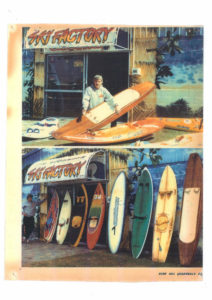
Jim Woodriff at his ski factory in the early 80’s
Besides the competition and organisational structures in place in South Africa, international stand up surfers reported the skills of the Australian ‘paddle surfers’ Down Under. The pioneers of the sport in Australia were Hayden Kenny and Jim Woodriff in Queensland, Jim Weily, John Gibbins and Bill Wallace in Sydney, John Egan in New Castle, and Fred Pike in Victoria. Later, a more radical group of designers in the late seventies led by people like Rodger Shakleton, Phil Avalon and Doug Holliday. Rodger Shackleton’s revolutionary designs (for the time) were small and required skill to surf, and many casual waveskiers opted to stick to the larger “goat boats”, more suitable for point break at the Gold Coast. With no initial organisational structure to administer the sport on a national level, contact between paddle surfers happened at an informal level through clubs. The Currumbin Sea Sports Club, formed in 1974 on the Gold Coast, was the first club in Australia that catered for waveski’s.The club conducted several competitions throughout the year and staged the Queensland Titles, first won by John Holmes in 1974. The club held waveski competitions and Queensland State Titles yearly until 1979 when the Gold Coast Club was formed as a separate entity. State champions were John Holmes, Peter Reaburn, Peter Anderson, Jim Woodriff, Jim Weiley and John Broadhurst. The Queensland organisational structure was more formalised in 1981 with the founding of the Sunshine Coast Club followed by the North Coast Club and the organising of the Queensland Association in 1983.
The Australian state of New South Wales (NSW) was led by Roger Shackleton and Phil Avalon. They arranged for a group of waveskiers to get together and the first NSW State Titles was held in 1978. In 1980, Phil Avalon organised the largest of the competitions at the time in the region, which was sponsored and offered $3000 in cash for prize money. The event attracted media and other interstate competitors like John Matthews who went back to their own regions to promote the sport further. Soon after this event, the Australian Waveski Association was formed.
World titles in the making. The first World Titles for ‘paddle surfing’ was being planned and a ‘Pre-Worlds’ competition was organised for Montauk in 1980. The event was again attended by teams from only South Africa, the United States and Britain. The event was won by Kola le Roux of South Africa.
Time to bring on the Aussies. Back in South Africa, the Festival Games in 1981 provided the South Africans with the opportunity of inviting an administrator of the Australian Waveski Association, Nigel Hobbs to South Africa. He witnessed both the South African Championships and the Festival Games. The result was positive and immediately a team of 6 top Australians, led by Paul Wise and Roger Shackleton, arrived in South Africa in 1982 for a series of contests. They brought with them short, narrow, high-backed, unstable skis which were exceptionally manoeuvrable but difficult to paddle out through a break.
Although the South Africans won each of the three contests, it was clear that the Yak type ski’s was clumsy and unmanageable. This event was followed by a period of experimentation in ski shapes and designs by the main manufacturers such as Raider in Australia, as well as Macski and Kolaski in South Africa. These skis were hollow with a fitted drain plug, also known as pop-out skis, as it was mass produced from a mould.
As the South Africa national body was the most financially secure and most organised, they accepted the responsibility of trying to organise an international competition. The World Titles which were intended to follow the 1981 Montauk contest had never materialised.
The inaugural world titles to be organised and held in South Africa was planned for February 1984. Entries were invited from the United States, Britain, Australia, France and Japan but only riders from Australia, Britain and South Africa participated, the other countries having few organisational abilities.

John Christensen Dee Why Point
The internationals first met the local riders in Open Competitions at Nahoon Reef (East London) and Victoria Bay (George), winning these events and providing stimulus to the average rider. The World Titles followed in Cape Town at Noordhoek where the Australians won convincingly. John Christensen and Paul Wise from Australia took first and second, followed by South Africans Ronnie Ackerman (third) and Kola le Roux in fourth place. Michael Petrie (Australia) was fifth, and Pete du Preez (South Africa) finished in sixth place. It was after these world titles that an explosive reformation occurred and the sport as we know it came of age.
The mid-eighties: An explosion in numbers and awareness. Production waveski were now common and mass produced with Macski, Kolaski and Black Widow being the most common brands in South Africa. In Australia, Raider and Wave Master were very popular.
The World Waveski Surfing Association was up and running, with Paul Brockman from South Africa in charge as the first President. The initial focus of WWSA was to arrange world titles at regular intervals. The second official world title was held at Diamond Beach in Hawaii in 1986. These events are run in different age categories, which include an “open” division where all ages could compete to crown the ultimate champion. John Christensen, by now already a legend, again won convincingly. By now it had become clear who the mainstream waveskiers in the world were. Names like John Christensen (Aus), Neal Decker (Aus), Michael Petrie (Aus), John Payne (Aus), Ronnie Ackerman (SA), Kola le Roux (SA), Mike Fourie (SA), John Macleod (SA), Craig Harburn (SA), Craig Seale (SA) and Kieron Davies (UK) soon became familiar names. Tracy Sassen (SA) started her reign as the best female waveskier in the world when she won the women’s division.
The big boom. Roger Shackleton and John Christensen released a book “All about waveski” in 1985. They also took on the waves in Hawaii and produced a waveski movie in 1986 called ‘Beyond the Limits’. The movie featured both of them together with Paul Wise and Michael Petrie doing surfboard-like moves with control and consistency. 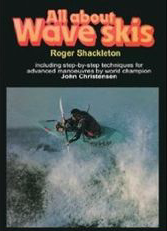
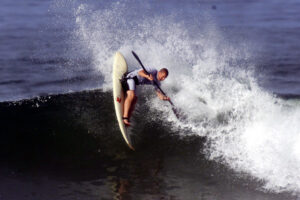
Nikki Carsten off the top at JBay
In South Africa, the exposure to scholars and students in official inter-school competitions and the annual South African University (SAU) Championships held at Jeffreys Bay became very popular. SAU champs that later became world champs includes Mike Fourie, Alistair Macleod, Nikki Carstens, Michael Orsmond and Adrian Voss. These second tier competitions were very similar to the model being followed in Europe at the time.
Waveski manufacturing was becoming very high-tech and technical, with the top waveskiers starting to experiment with custom ski’s, shaped out of polystyrene and glassed like a surfboard using epoxy resins. Wave Master, in Australia, also developed and produced quality waveskis on a huge scale, while the South African manufacturers continued with pop-out skis. The South African waveskis were now foam injected, to provide strength and allowing for a thinner layer of glass fibre. Ski’s weighed in at around 7-8kg, allowing for better manoeuvrability and overall performance.
John Macleod from Macski employed a professional surfboard shaper, Greg Gardner and custom shaped Macskis were produced in huge volumes and exported to European countries, but mainly to France. Kola le Roux from Kolaski also expanded production and exports. By this time the Kiwi’s were on board and the Tsunami brand of ski’s had been established. Top performing waveskiers started to manufacture their own custom skis on a “by-order” basis. In Australia, John Christensen shaped and sold his custom brand that he labelled “Christo”. Roy Scaffide from Island waveskis in Florida, USA, also produced quality custom built waveskis for the American market. This stimulated the awareness and growth of the sport in the USA. Roy also later became the President of WWSA for a term in 1999.
The first world’s title in Australia was held at Yamba Beach in Australia, where John Christensen retained his world crown. The next year the event moved to Europe for the first time and was held in England at Fistral Beach, Cornwall. A younger generation of waveskiers make their presence felt. John Christensen was well beaten by a squad of junior waveskiers from all over the world. Rees Duncan (Australia) won the open division with juniors Dave Mitchell (NZ) and Alistair Macleod (SA) all making their presence felt. The junior waveski surfers, with their quality of surfing, took the sport to
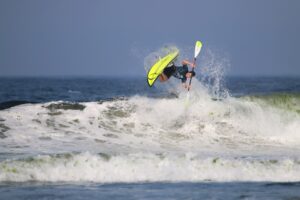
Rees Duncan taking flight
the next level. Alistair Macleod, eldest son of the legend John Macleod, followed in his dad’s footsteps to also claim a world title in the junior division. This was the second Macleod to win a world title.
In the nineties, numbers started to drop. Unfortunately even fun-loving waveskiers had to face the reality that technology and intensive labour costs money. Everyone wanted a custom ski, resulting in the economic law of supply and demand producing a double whammy on the waveski industry. Demand for the cheaper mass produced pop-out ski’s dropped to almost zero in the southern hemisphere, and because custom skis take longer to manufacture, requiring more skills and costs to produce, the supply for waveski was impeded. This drove the price up and only the really dedicated, hard core, waveskiers remained in the market. Because of the cost, the average entry age to the sport also increased. It was simply more affordable and practical for parents to buy a body board for their teenage kids than a waveski. Kite surfing provided stiff competition for the likes of waveskiing and other surfing disciplines, making entry into the sport somewhat less desirable than the latest craze. Things were not looking good for the sport, but the show went on.
Besides the drop in numbers, the standard and quality of surfing continued to improve with the use of custom shaped skis. The sport did not only grow in Europe (especially France), but the French and Brazilian’s began to entering WWSA events. The first world’s title during this decade was held in the USA, at Huntington Beach,. Steward Lawson of Australia won.
The World Titles scheduled for Australia in 1991 were marred by controversy as it was down-graded to the Australian Open. This happened due to the South African entrants being disallowed to compete due to political sanctions held against South Africa at the time. The event was won by Rees Duncan. The French then hosted their first international waveski event in 1992 at La Torche in France. Many South Africans entered, and dominated, the event. Craig Harburn won. But this was also the beginning of a long relationship between Nikki Carstens and the French waveski fraternity. Nikki spent a few years in France and shaped custom waveskis for local manufacturers.
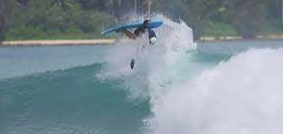
Mike Fourie charging Indonesia
In 1993, the world titles were shifted to Nahoon, East London, in South Africa. John Christensen made a comeback and won the open division with strong competition from South Africans Nikki Carstens and Mike Fourie. Fourie won the seniors division. Lisa Ryan of Australia won her first of five world titles at this event in the woman’s division. She was unstoppable for the next five years.
Although not as competitive yet, the French were well represented and their numbers were clearly showing signs of growth. They put in a bid to host the 1995 World Titles in Lacanau, France, which WWSA awarded to them. However, before the French world title event, the Kiwi’s held their first world title event in 1994, in Gore bay, New Zealand. Neil Decker won that year.
The French moved to the forefront. Other than Australia and South Africa who had their own independent national waveski surfing associations, the French (and Brazil) waveski administrative structures were affiliated to their respective national canoe and kayak federations. With the backing of the French Canoe Federation, France hosted one of the most professional world events to date in Lacanau, France in 1994. The open division was won by Michael Orsmond of South Africa, but saw the first French Champion crowned when a young and unknown Mathieu Babarit won the junior title. Due to distance and cost to travel from “down under”, the Aussies and Kiwis was not well represented at this northern hemisphere event. Nikki Carstens decided to spend time in France and started to shape waveskis for the French. There was a notable buzz in France.
The French later saw their own manufacturers KS, and Rotomod coming to the forefront. With subsidies from the French Canoe Federation, the sport was promoted at school levels. The French experienced what Australia and South Africa did in the eighties, just with far better financial support from the Canoe federations that also encouraged manufacturers to expand.
The World Titles in 1996 returned to South Africa and was hosted in Durban. This event was run by computer programmer Pey Geldenhuys who developed a computerised judging system that was subsequently used at three world title events. The open division was won by Munro Kendrick of South Africa. John Macleod won his third world title when he won the Grand Masters division. In 1997, the Aussies hosted the World Titles in the Gold Coast, Queensland. This event attracted waveskiers from across the world including Australia, Brazil, France, and New Zealand. South Africa was well represented but missed names like Mike Fourie, Nikki Carstens and Munro Kendrick. John Christensen, now in his mid- thirties, entered the championships, where his toughest competition came from a younger countryman, Rees Duncan, and two Kiwis, Tony Cherry and Dave Mitchell. In a spectacular final at Surfers Paradise in the Gold Coast of Australia, John Christensen once again won and proved that he was still good enough to beat the best waveskiers in the world. This was a sign that one can stay competitive for a long time in the sport. Neil Decker (Australia), who won the seniors titles that year and later in 2005, became the oldest waveskier to win an open (all ages) division when he won in Brazil.
The 1998 world titles was held in the northern hemisphere, and for the second time was hosted in Cornwall, England. Most entries were from European countries. Manu Gedron won the first open division title for France.
Waveski Surfing Rulebook developed and published. In previous events, waveski surfing rules were based on the surfing rulebook. This created problems at times as it was written with a professional circuit in mind and not an amateur status sport. Penalties were set in the form fines, and the format of flows not 100% suited for waveski competitions. WWSA, under leadership of Bradley James as President and Wayne James as the Contest director, edited and tailored the rules and published the first edition of the WWSA Rulebook. As per the rulebook, world waveski surfing events and the world waveski surfing championships include the following events: a) Cadet Championship 13-16 years both genders b); Junior Championship 17-20 years both genders; New Age Championship 21-29 years both genders; d) Senior Championship 30 – 39 years both genders; e) Master Championship 40 – 49 years both genders; f) Grand Master Championship 50-59 years both genders; g) Veteran Championship 60 years plus both genders; h) Women’s Championship 13 years plus women only; i) Open Championship 13 years plus, open to both genders.
After a submission by Naudé Kotzé and Ken Clements to the WWSA, the rulebook was further expanded to include a tag team event to include the top six men and top two women of the participating countries.
The Brazilians now had their turn to host the world titles on the Brazilian Island of Florianopolis. Nick Boon from Australia won the open division event. The Basque Country was keen to bid to host an event but it was a submission from South Africa to host a “top 16 invitation only” event that attracted the attention of the WWSA. The South Africans obtained approval to host an international event at Supertubes in Jeffreys Bay, two weeks before the Association of Surfing Professionals (ASP) world tour leg. The South Africans were hoping to invite the top elite sixteen waveskiers and put up a big cash prize – winner takes all. The WWSA rejected the proposal, but since J Bay had been secured as a venue, requested that the South Africans host the World Titles in Jeffreys Bay in 2000. This gave the South Africans only 7 months to prepare an event for 120 entries, instead of sixteen.
Taking waveski to ‘Centre stage of surfing’, J bay, Supertubes. Returning to Jeffreys Bay surfing community with the counter offer, it took endless negotiations for the South Africans to come up with an agreeable solution with the local surfing community and authorities. It was eventually agreed that the preliminary rounds of the open division and all other divisions would be run at Surfers point in J bay, and the top 16 of the open event got the green light for Supertubes. The surfers were very sceptical that the waveskiers would be able to handle Supertubes, also referred to by many as the ‘Centre stage of surfing” in South Africa. Unfortunately, John Christensen’s name was not on the Aussie entry list, but there were plenty of elite names that entered. The scene was set to showcase the sport.

Neal Stephensen
Winning the respect of the surfing fraternity at Supertubes. The event went well at Surfers point and the surf gods were on the organiser’s side when it came time for the well anticipated quarterfinals (top 16) of the open division at Supertubes. Big names like Mike Fourie, Nikki Carstens, David Mitchell (NZ), Mathieu Babarit, Ian Macleod (son of legend John Macleod) were all in to take the title, but it was a new, unknown former professional body board champ that surprised everyone to be amongst the elite group. Neal, a former South African and international body board champion, who had survived a near fatal shark attack two years before, lost part of his right leg as a result, started waveski surfing just a year before the event. [ see photo of Neal taken in the final]. In super hollow, low tide conditions, Supertubes produced thrilling waves. WWSA President Roy Scaffidi (USA) commented at the time that the waveskiers looked like gladiators battling it out in the waves to get to the finals. Neal Stephenson made all the way into the finals and this achievement attracted huge media attention. This provided the perfect opportunity for the media to also take note how radical and technical the sport had become. Fighting though the loser’s flow, Nikki Carstens, with smallest of margins, won with Mike Fourie second, Neal Stephenson third and David Mitchell (NZ) finishing fourth. Nikki Carstens went on to also beat Mike Fourie in the senior division, making him the first waveskier in the history of the sport to win two categories at one world title event. Sixteen year old Caroline Angibaut from France won her first world title. She went on to dominate this division for the next decade.
The local surfing fraternity and media who watched the finals were stunned with the level of surfing that they had during the finals at Supertubes. It became clear that the dated perception that waveskiers were a bunch of dangerous, out of control hackers, had been wiped out for good.
One of the South African national tag team members, Xaver Walser spent three years traveling in Indonesia together with his friend, Malan Calitz. They filmed their experiences and surfing sessions and made movies to show their friends of their experiences. He was surprised with the reaction and demand for their movies and ended up selling a few hundred copies. Xaver decided to film the world titles tour on a mini-dv format camera, the same format used by TV-news crews. The SABC TV news crew did not schedule to cover the finals at Supertubes, but word between the media soon had them change their mind. They made use of Xaver’s footage of the finals which screened on the TV news that day. Subsequent to the event, National Geographic made a documentary on shark attacks that, amongst others, features attack victim Neal Stephenson. They later also obtained the footage from Xaver on Neal surfing the world waveski finals. This provided Xaver an incentive to start a career as a freelance filmmaker.
Subsequent to this event at J Bay, South Africa hosted pre-world tour events in 2006 and 2014 at Jeffreys Bay.
Ordinarily, waveski surfers strap both legs into foot straps, however, despite not having two legs, Neal Stephenson was able to strap himself to his waveski using a quad belt, and he was able to bring his body board-type waveski to the waves. He was filmed in 1999 successfully doing an Aerial Reverse Spin (ARS) on his waveski. This encouraged many young waveskiers to experiment and take the manoeuvres to extreme levels. Aerials were no longer just about getting the ski out of the water – getting inverted became the benchmark for doing aerial drills. The design of waveski’s also allowed the rider to surf closer in the pocket, with surfboard like powerful spray manoeuvres in the most critical section of the wave.
The French start to take control. During the 2000s the French – led by Mathieu Babarit – had become a force to be reckoned with. Supported by the French Canoe Federation, they were going from strength to strength. By now, local French manufacturers such as Vincent Thepaut, with his KS-designs, as well as the RTM’s RotoMod Slide Master waveskis, began emerging during this decade.
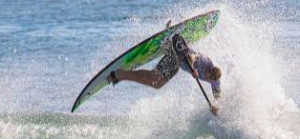
Darren Kearns taking to the air on the Gold Coast
The 2001 world titles moved to Europe, held in Bakio, Spain. Darren Kearns won the open event that year. The event shifted back to the Gold Coast, Australia in 2002 and Dave Dinning from Australia won the open division that year. The sport also spread to other French colonised countries, such as the Seychelles in the Indian Ocean, and Guadeloupe in the Caribbean. The 2003 world titles were hosted in Guadeloupe, and the French team dominated the results, marking the start of Mathieu Babarit’s dominance when he won the open division for the first time.
But since 2001, SAWSA faced another battle. Waveski as an official sport was continuously scrutinised and closely monitored by the South African Department of Sport and Recreation. The sport was at risk of losing its status as an autonomous sporting body in South Africa. Membership dropped since the early 1990’s and the numbers simply did not meet the government requirement for government funding and recognition. The dilemma of quality versus quantity that escalated since the eighties as a result of the technical evolution had caught up with them. Although financially still sound, SAWSA was simply not in a position to meet the strict compliance requirements to sustain the status quo. For a few years, SAWSA executive members, Pey Geldenhuys and Naudé Kotzé, spent more time negotiating and meeting with government officials than what we did in the sea. They soon realised that the writing was on the wall, and they had to come up with a new plan and structure for the sport to survive.
In 2005, the World Titles was again hosted in Florianopolis, Brazil. In a closely contested open final, Neal Decker from Australia, at age 40, became the oldest winner of the open division when he beat Mathieu Babarit. Multiple British and European champion, Kieron Davies won the first world title for England by taking the masters division.
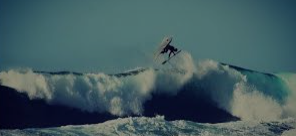
Mathieu Babarit in Hawaii
Start of the transformation in administration. The World Titles moved again to South Africa in 2006. This time it was Durban that played host city with Pey Geldenhuys organising the event without government support or funding. Although South Africans dominated other divisions, it was Mathieu Babarit that once again triumphed in the open division. But it was perhaps not the competition that kept administrators busy at this event. During the negotiations with the South African government department, SAWSA was invited to join the South African Surfing Union as a separate discipline. Considering the steady growth of other European countries, in particular, France, SAWSA looked at the reasons why they had managed to grow since the nineties. The answer seemed obvious – waveski was part of the canoe federations in those countries, as the sport has more in common with kayaking and canoeing from an administrative and organisational structure point of view than what it has with surfing. More waveskiers were involved with other organised “paddle” sporting clubs such as surf ski, canoeing and kayaking than they were with surf clubs. It was then that SAWSA opted rather to affiliate with Canoe South African as a separate discipline. This move aligned them with the Europeans and Brazilians. SAWSA President , Naudé Kotzé, with the support of the French and Brits proposed that the WWSA should approach the International Canoe Federation to become affiliated with them. A motion was carried at the WWSA’s Annual General Meeting in Durban, 2006 for this to happen. Jackie Dillon, President of WWSA now had the daunting task of setting the wheels in motion.
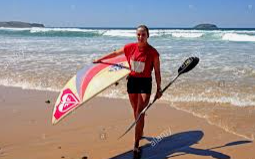
Caroline Angibaut Emerald Beach Australia 2009
Xaver Walser, who filmed the 2006 World Series in South Africa, had by now relocated to live in Switzerland where he started Subgraviti Productions. He produced various waveski movies and promotional clips for manufacturers and organisations in Europe. These movies feature the top waveskiers of the decade that include Nikki Carstens, Malan Calitz, Mathieu Babarit, Julien Billard, Caroline and Lionel Angibaut, Blair Moore, Ben John, and Andre Burger to name a few. This together with social media sparked great renewed awareness of the sport.
The world titles continued and world titles were subsequently held in Gisborne, New Zealand in 2007 and at Emerald Beach in Australia in 2008. Rees Duncan won crown as champion at both events in the open division, proving beyond doubt that he remains one of the greatest waveskiers since the late eighties.
WWSA now part of International Canoe Federation. In January 2010, after huge effort and time spent by WWSA in negotiations, Jackie Dillon, President of the WWSA, announced that the association had signed a cooperation agreement with the International Canoe Federation, and a Joint Venture Committee had been formed to work on technical matters. The WWSA also updated the Constitution and the Waveski Surfing Rulebook. The sport is in a healthy space and surely here to stay for a long time.
2011 flagged the start of a new era in the sport when the world waveski titles were held in conjunction with the surf kayak titles at Santa Cruz in Portugal. Virgile Humbert was the top of three French waveskiers and won the open division. Sandra Pienaar at age 42 became the oldest woman in the history of the sport to win the women’s division. She successfully defended her title in 2014 in South Africa. Stephen Farthing won the masters division. Stephen also took up surf kayaking in 2009 and is the current World No 2 in this sport. This is a clear indication of how closely the two sporting disciplines have developed.
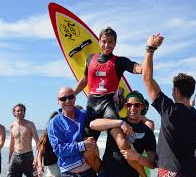
Renan Leloutre
The world titles were recently held in South Africa in 2014. Renan Leloutre from Guadeloupe won the open division. Mathieu Babarit won his sixth world tile when he won the seniors division. This makes him the waveskier that has won the most world titles in history. Ian Macleod won the masters division. What makes this win remarkable is that he became the third member of his family to win a world title, following in the footsteps of legendary dad John, and older brother, Alistair. This makes the Macleod’s from Port Elizabeth, South Africa, the most successful family in the history of the sport. Ian currently still manufactures custom made Macski waveskis.
